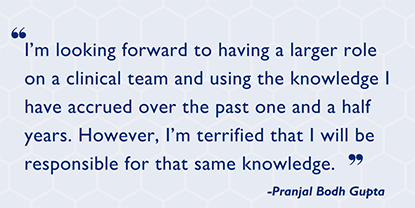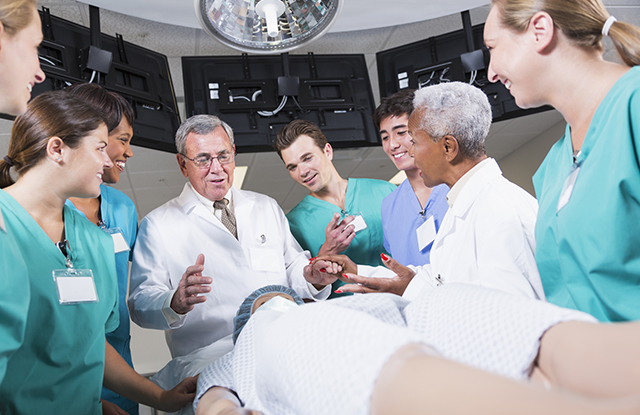Medical school curriculum has traditionally been split into two halves: preclinical and clinical years. Preclinical years generally include the first two years of medical school, when topics including anatomy, biochemistry and organ system-based physiology, pharmacology and pathology are taught in lecture halls. At most schools, clinical years encompass the last two years of medical school, during which medical students rotate through various services in the hospital, learn to take care of real patients by applying preclinical knowledge, and are taught directly by residents and attending physicians.
At the Johns Hopkins University School of Medicine, however, the timeline is slightly accelerated. Our preclinical curriculum, named Genes to Society, concludes in mid-February of our second year, followed by the three week course Transition to the Wards. Next comes spring break, and then in mid-March half of the second-year class begins dedicated study time for the Step 1 United States Medical Licensing Examination (USMLE), the first of three national board exams required to practice medicine in the United States. The other half of the class begins rotations on the wards, as decided by the Office of the Registrar and student responses to a survey indicating their preferences for order of rotations and Step 1 studying.
In just a few short weeks, I will start my first rotation as a medical student. Where has the time gone? Recently, I was reflecting on my experience cutting through a cadaver for the first time, and donning a white coat through the hospital halls. I distinctly remember the first day of medical school, finishing the anatomy course, and finishing my first year. Suddenly, I’m carrying those experiences with me as I truly begin to immerse myself in medicine and patient care as a rotating medical student.
 Starting rotations comes with a complex set of emotions for me. I love hands-on learning, and I’m incredibly excited to start learning on my feet, with actual patients on actual hospital wards. I’m also looking forward to having a larger role on a clinical team and using the knowledge I have accrued over the past one and a half years. However, I’m terrified that I will be responsible for that same knowledge. The past year and a half flew by, and I’m honestly not sure what happened to the thousands of facts and moments of understanding about the physiology of the heart, or pathology of the liver, that, at one point, I knew sufficiently well to pass an exam. Passing an exam is one thing, but using that same knowledge to take care of a patient by coming up with a differential diagnosis and management plan seems like a completely different, and much more intimidating, scenario. Quite often though, I surprise myself by the amount and breadth of knowledge I truly have digested. In the most innocuous of moments, such as reading medical literature or recognizing a drug from a television commercial, I remind myself of how far I have come and the confidence that I should have moving forward in my education. In some ways, the imposter syndrome of wearing the white coat is beginning to fade, yet in other ways, the fear of not belonging or not knowing enough material is still very real.
Starting rotations comes with a complex set of emotions for me. I love hands-on learning, and I’m incredibly excited to start learning on my feet, with actual patients on actual hospital wards. I’m also looking forward to having a larger role on a clinical team and using the knowledge I have accrued over the past one and a half years. However, I’m terrified that I will be responsible for that same knowledge. The past year and a half flew by, and I’m honestly not sure what happened to the thousands of facts and moments of understanding about the physiology of the heart, or pathology of the liver, that, at one point, I knew sufficiently well to pass an exam. Passing an exam is one thing, but using that same knowledge to take care of a patient by coming up with a differential diagnosis and management plan seems like a completely different, and much more intimidating, scenario. Quite often though, I surprise myself by the amount and breadth of knowledge I truly have digested. In the most innocuous of moments, such as reading medical literature or recognizing a drug from a television commercial, I remind myself of how far I have come and the confidence that I should have moving forward in my education. In some ways, the imposter syndrome of wearing the white coat is beginning to fade, yet in other ways, the fear of not belonging or not knowing enough material is still very real.
Rotating through the hospital will truly be the beginning of a new era, and the end of another. From this point onward, I am beginning my clinical career and ending a long, 18-year career of learning from schoolwork, lectures and textbooks. Although the learning will never stop, the methods will drastically change. With that comes new, exciting experiences and challenges, and I can only express my utmost gratitude for being given these opportunities.
